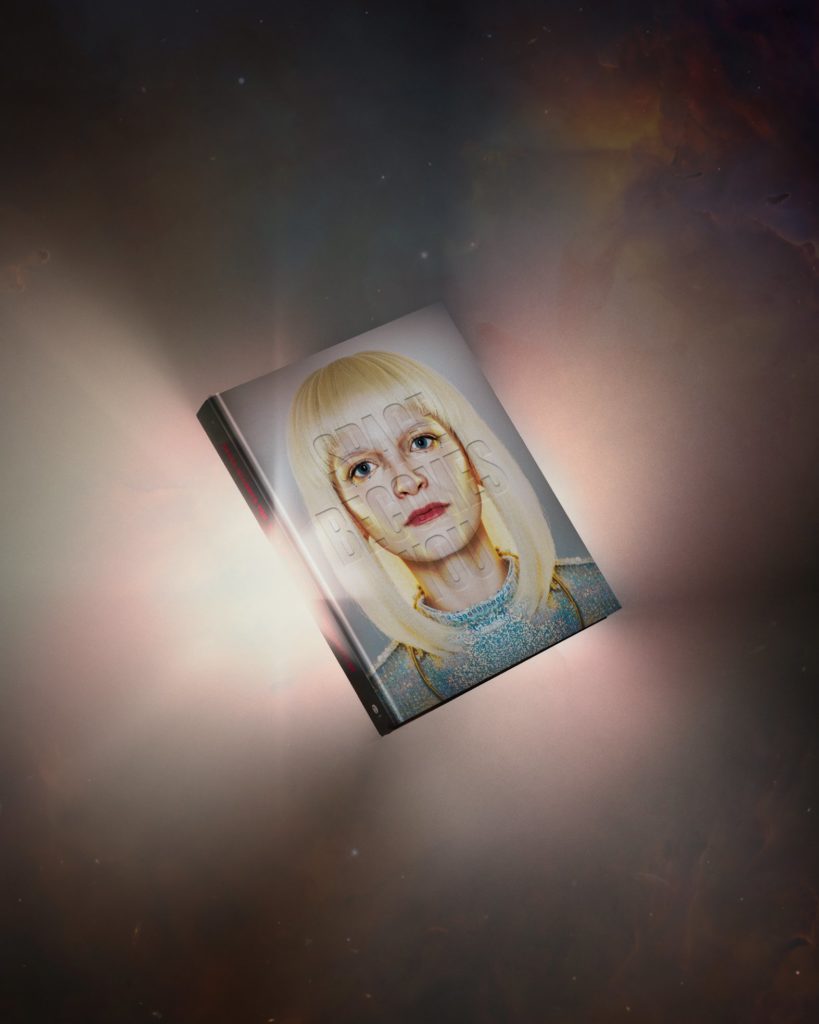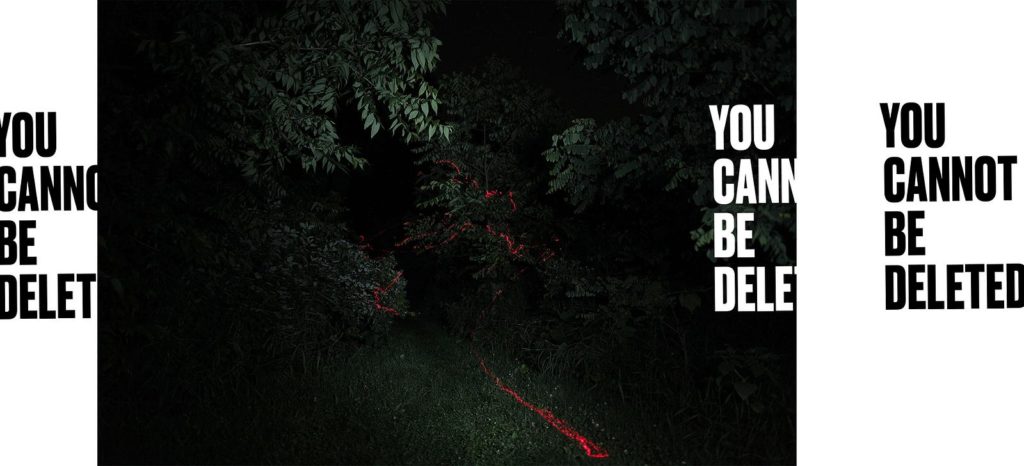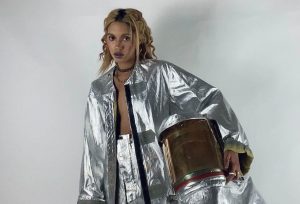photos from the Space Becomes You Digital Gallery
On December 7, 2018, Scapi Magazine met with Chris Eichenseer and Anton Jeludkov of Someoddpilot and Public Works Gallery to talk about combining media to build worlds and creating the puzzle pieces before really knowing what the final image is. Things get existential.
Eichenseer and Jeludkov are two of the brains behind Space Becomes You, which opened in November 2018 and closed in February 2019. The exhibit was a multimedia elixir of fashion apparel, film, and a photo book, which was released this month, April 2019.
For those who are unfamiliar with Someoddpilot, it’s a design studio and branding agency that started as an electronic and post-rock Chicago record label, about 20 years ago. Now, Someoddpilot does website design for companies like Empty Bottle and Pitchfork.
“To be honest, I was always obsessed with album covers and photography. That was my background, photography, and quickly rolled into, okay, we’re making websites now, for record labels,” said Eichenseer. “A business I did not plan to go there started moving there organically, because we were just sort of dialing into audiences.”

How does branding relate to the creation of a sci-fi art show with a sublime and cosmic atmosphere? World building, Eichenseer and Jeludkov explained. Eichenseer cited Hypnosis, a 1960s London design studio, which inspired him with their album cover designs.
“Because they took it so far conceptually and photographically, they kind of defined album covers as this world building exercise where you create this mysterious land, and music sort of populates that land,” said Eichenseer. “What is more arresting than being hit in the heart by music while staring at these images?”
“It’s that transfer from image to sound, and together they build something,” added Jeludkov.
Space Becomes You is a world Jeludkov, Eichenseer, and their creative team built from a vast amount of images, text, and sound. The show featured, for example, a 450 million year old fossil that Eichenseer pulled from the ground in Door County.
“A lot of world-building is the selection, curation, and assembly of little windows into different worlds that, when placed into the blank canvas of a gallery, kind of complete a narrative or suggest a viewpoint or idea,” said Eichenseer.
The exhibition is a manifestation of their subconscious ideology that Eichenseer and Jeludkov wanted to make accessible to the public eye. With a background in conceptual photography, Eichenseer wanted to use his craft to create material that would resonate with audiences more deeply than a typical fine arts gallery might.
“People are hungry to experience music and to see album design because of that world-building experience, that mythology. There’s an appetite for that that’s maybe lacking for most modern art,” said Eichenseer.

That is to say, the creators of Space Becomes You wanted viewers to feel unafraid of the art space, to be able to absorb the world Someoddpilot created for them and, not only feel comfortable, but have fun. Hence the name of the gallery, Public Works.
“Things where people can draw a lot from it and kind of fall into it, because they can see the connection to their emotions and everyday lives,” said Eichenseer. “It doesn’t have that remove that fine arts has built into our culture, it has more direct relevance.”
The handout given to Space Becomes You viewers instructed them to travel through the exhibit counterclockwise from the door, creating a sort of interactive quality from the very beginning. There was also, on opening night, a dance party upstairs. Lots of people, Jeludkov mentioned, showed up to dance.
“It started off as tame. At the opening event, people could walk around and take it in. Towards the end of the night, when it got closer to the dance party upstairs, it morphed into something else,” said Jeludkov. “It felt like the dance party was an extension of the experience you had downstairs.”
Eichenseer and Jeludkov curated Space Becomes You deliberately, but they didn’t ascribe meaning to their material until after they created it. They knew they were tackling subjects of mythology, a “belief system for non-believers,” as Eichenseer put it, but allowed their process to be playful. They entered the project with only the notion of creating a world from scratch.
“We had, kind of, the source of ideology that had a lot of narrative weaved into it and a lot of philosophy that could be the grounding element for a lot of this,” said Jeludkov. “We created all the puzzle pieces without knowing what the final thing was.”

The two experimented with light, props, models, and objects in their photography studio to populate their world with images guided by their subconsciouses. Soon, their entire studio floor was covered with such images.
“Building that, all the sudden started becoming this art book, because the images were racking up by the dozens,” said Eichenseer. “We were all sitting around the computer,manipulating the images to our hearts’ content, and they were becoming these other worldly things. Why were we doing that?”
Apparel become part of the media mix as the images began taking a fashion air. They asked themselves, could the look or attitude of a mythological world translate to clothing? Naturally,their next step was to involve film.
“There’s a narrative going on here, so what does it look like when it moves?” Said Eichenseer.
During this process, the team also discovered a European UFO cult whose beliefs reflected some of the themes gestating in their own minds.
“What if we bent it into a non-supernatural, freaky zone and made it this belief system for non-believers, but using the universe as the awe-inspiring thing that the cult also understands,” said Eichenseer.
They translated passages from the website’s Eastern European language into English and kept some of the translations cryptic or broken, because they found the tone of the phrases to fit their world. Plus, reading imperfect language gives audiences the sense that they’re glimpsing into a genuine world outside of their own. Some phrases they took from the site are “our open hearts shall change the world” and “we transmit only that which serves the purpose of lasting peace.”
As artists, world-building is part of Eichenseer and Jeludkov’s day-to-day. What Eichenseer did not expect about creating Space Becomes You is that it drew him back to his experience caring for his dying father. Particularly, their conversations about life and death.
“We had a lot of conversations where I tried to explain my fascination and awe of the universe and this bigger thing that makes no sense, with dark matter and dark energy and these billions of stars in our galaxy, and how we just happen to live next to this one,” said Eichenseer.
Another UFO cult quote featured in Space Becomes You was, “you cannot be deleted.”
“My way of thinking is, well, if we all know that we’re made from remnants of an exploded star, then what are we fearing about death, when we know that the system is a closed system, and if we were part of the universe before, we’ll still be part of the universe later,” said Eichenseer.
Eichenseer said that the Space Becomes You art book is 300 pages of everything he’d ever thought about life. If he’d had it while his father was still alive, he would’ve given it to him.







Be First to Comment